by Dean Alexander
The first steps toward vineyard formation
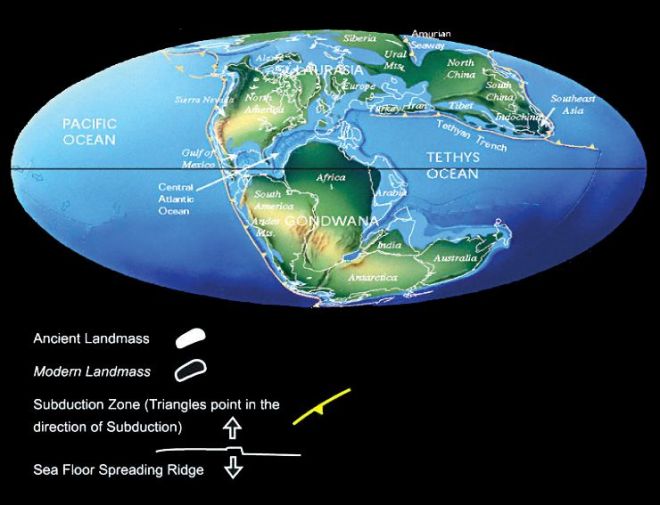
Burgundy’s story really is one of stone into the earth, and pivots on a cast of geological stress, sub-freezing temperatures, and the simple, transformative power of water. Just how the forces of nature may have acted upon the limestone and transformed it into the great wine region it is today, is the subject of this article. Meanwhile, the ultimate goal of this series explains the intimate relationship limestone has with the wines of Burgundy.
I suspect that we all have this image of the Côte, post-Fault Event (however long that took), to be this raw 400-meter face of sheared limestone. But even then, the Côte was not a solid piece of stone. The incredible extensional forces the broke the Côte d’Or free from the Saône would have caused significant tension fracturing throughout the Côte before this much more massive fault gave way.
Just Add Water
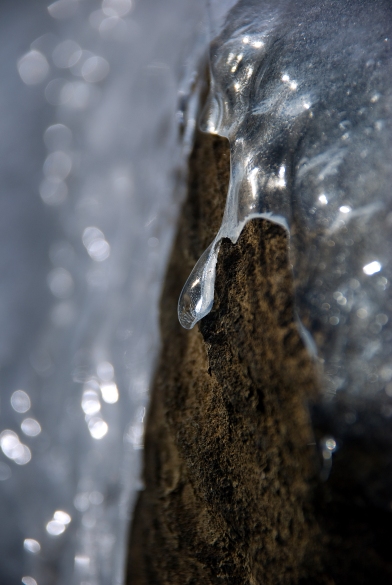
This tensile fracturing, which surely was extensive, would allow rainwater to deeply infiltrate these fine crevices of the stone. And then, upon each surface that the water contacted, depending on the specific porosity and permeability of the limestone, rain water would penetrate the surface of the stone. This contact with water would set the stage for two very different yet significant developments in the stone.
With winter temperatures below freezing, the water in the stone will expand between 8 and 11 percent. This will yield 2000 pounds per square inch, or 150 tons per square foot of internal pressure which is more than enough to cleave the stone. Geologists call this frost wedging, a form of mechanical weathering which breaks apart the stone due to thermal expansion and further with the eventual contraction. Thermal expansion has a culprit in shattering the stone: the cold. Most materials are inherently brittle in colder temperatures, and the limestone which has more elastic than brittle tendencies is more vulnerable to fracturing in freezing temperatures. Frost wedging is so successful in nature that the stone industry mimics it as a non-explosive technique to separate pieces of stone.
The effect of successive freeze thaw cycles, even upon undamaged exposed stone can cause the development of micro-fissures that influence the stone’s fatigue strength, and can produce vertical cracking called exfoliation joints, as well as flaking, and spalling. All along the Côte, there are numerous scars on hillsides where limestone has in the past loosened, to slide off of even moderate slopes, sending scree down the hillside to rest at the curb of the slope. Geologists refer to this rubble pile as colluvium, and it has proved a near perfect vineyard soil solution. The sliding and falling of rock further degrades the stone, abrading it as it slides, and breaking as it falls, allowing fresh broken surfaces for water to act on. Frost wedging which in part created this colluvium rubble pile, is considered mechanical weathering, and is the first development that I mentioned water would bring. Equally important to vineyard formation, is the second significant development that rainwater brings, is chemical weathering. The acid carried by the rainwater, will metamorphose these freshly broken limestone surfaces. And like magic, it will slowly dissolve the calcium carbonate which binds the stone, leaving behind clay minerals and other material. (This process will be covered in Part 1.3 Clay and Soil Development)
Exfoliation and Other Theories on Geologic Structures with Unobservable Change

Consider for a moment: most significant geologic changes occurs over a time frame that is far longer than the entire the evolution of mankind. This fact alone might best explain the difficulties of studying events that happen so slowly that change is not observable. These are geologic forces that can not be seen, felt, or measured. If we didn’t have evidence that these changes had occurred, we would

never know they were still continuing to occur around us. The scale of time and shear size and immobility of the objects makes many traditional scientific methods impossible.
Exfoliation Theory: G.K. Gilbert 1904
We know that exfoliation joints exist, but scientists are at odds about how they occur. It is agreed that mechanical strain results in large horizontal sheets of stone separating itself from the mother rock. Half Dome in Yosemite has achieved its shape in this manner. The first, and once long-held theory, was put forth by the ground breaking U.S. geologist Grove Karl Gilbert. Gilbert’s theory of Mechanical Exfoliation concerned stone formations that had previously been buried in the earth’s crust, which were later were forced to the surface by geological up-shifts. The theory explained that the removal of the overburden (the weight of the rock or earth above) had caused unloading of stress in one direction. The resulting release of stress once on the surface and not confined upwardly, caused expansion and tensile cracking along unloading joints, eventually creating loose sheets of stone on the upper surface of these rock structures. These outer layer of stone were thusly being exfoliated. This website for Girraween National Park in Queensland, Australia, has an excellent explanation of exfoliation weathering.
Challenges to Exfoliation Theory
However, this theory has had it challenges by the mid 20th century, and is to some extent (depending on the point of view), muted or discredited. Situations were sited that didn’t fit all of the theory’s criteria, like rocks that with exfoliation joints which have never been deeply buried, and evidence that many exfoliation joints exist in compressive stress environments, rather than being produces by extensional stress as the theory suggests. Alternative theories are thermal expansion, (and even wide diurnal expansion), and hydraulic expansion, , (which I discussed above with frost wedging), compressional stress, and in the case of Half Dome, the weight of gravity, or a combination of all of the above, including exfoliation weathering.
Along the same lines, theories revolve around minerals that are created in an anaerobic environment. These stipulate some minerals molecular structure are changed (metamorphized) when exposure to oxygen, creating new minerals. While oxygen is the most common element in the earth’s crust, most of it is bonded with silicates and oxide materials and is not free to act as a weathering agent. But when minerals are exposed to free O2 above ground, they undergo chemical weathering, that produces new minerals that are stable on the surface. The most obvious example is when iron ions lose an electron with exposure to oxygen, rust is formed.
Bedding planes
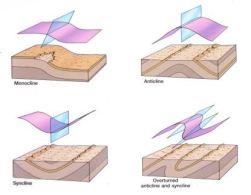
In many ways, I’ve put the cart before the horse by talking about the escarpment, before covering even more fundamental ideas. But that is how storytelling goes: sometimes you have to fill in the back story.
The world was a very different place 160 million years ago. This was five million years before the Allosaurus and Apatosaurus (formerly known as the Brontosaurus) roamed the earth. The limestone of the Côte, being a sedimentary material, was laid down in big, flat, shallow beds between the reef barrier that protected the lagoon, and the shore. Each layer was put down, one at a time, chronologically by age, marking millions of years. As the seas receded, and this is the main point, this would become a wide, flat valley of young, sedimentary limestone. It is likely that this bedding would eventually, be completely covered by wind-blown soils. We don’t know what happened to this young Burgundian stone in the intervening 130 million years between formation and the Fault Event, 35 million years ago, but it is unlikely it remained there unchanged. As geological stress acted upon the bedding, it would be pulled, pushed, deformed, and in all likelihood, in some way, fractured.
Author’s Note: For the remainder of this article, I will describe the stress and deformation, and potential fracturing of the stone in the body of the text, and in the photos I will show some of the results (that I am aware of), of that stress. Hopefully the two together will paint a complete picture.
It takes more than just ‘X’ to fracture
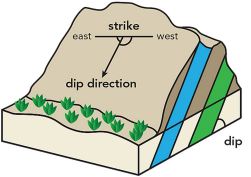
Tilted Bedding Planes: While all sedimentary bedding was laid out horizontally, various stresses can shift the bedding planes into other orientations. Geologist measures the tilt by dip, the up/down angle, and strike the percentage off of an east-west axis.
I would love to be able to write that a particular limestone will fracture under the “X” conditions, but just doesn’t seem to be that simple. First, there are too many variables. How stone reacts to geological stress is directly related to its composition and construction as well as: its temperature, the amount of stress, multiplied by the duration of stress. Most materials tend to be more elastic under higher temperatures and more brittle in low temperatures. It would be reasonable to assume that there was significantly more geological fracturing during ice ages because stone is more brittle in cold temperatures. At least in warmer temperatures, calcium carbonate stones tend to have good elasticity, depending on how pure their construction, as the chemical bonds in CO3 will move if pressure is applied very slowly. However, that elasticity is finite before the stone is structurally damaged as it passes its elastic limit; but more on that later.
Secondly, like I mentioned before, science cannot measure the stress, but rather the deformation due to the stress. For this geologists use a strainmeter, which they measure changes in the distance between two points. For greater distances technology has brought the laser interferometer. These tools allow the scientist to measure frequencies that represent deformation. Over short periods of time, they record tides (I had never before considered the stress created by a 1.5 quintillion tons of water moving position above earth) and the seismic waves of earthquakes, while over longer periods of time, it can record the gradual accumulation of stress of rock formations.
The mission of this article? What I am looking for here, are some kind of answers these two questions: What conditions would make it possible for vine roots to bed into limestone bedrock? and What limestone types will fracture enough to allow this to happen? Anything learned along the way will be a bonus.
Stresses and the resulting strain
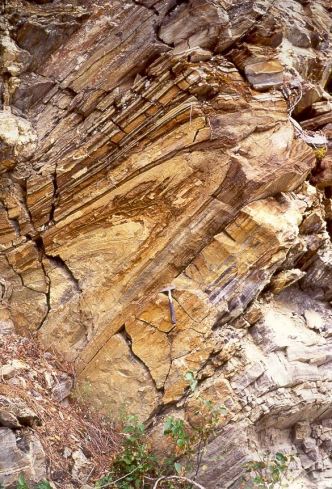
Stress causes strain of various types. Like I mentioned before, we are not able to measure the stress itself, rather only its effect by measuring the stone’s deformation. Below are the basic stresses upon objects and the resultant strains and deformations associated with them. Any deformation is considered flow (as science calls this) and it is domaine of an interdisciplinary study called Rheology. Here it is again, more simply, because its getting more complicated: Stress first. It, in turn, causes strain. The result can be deformation, and this deformation is studied as if it were a liquid: as flow by Rheologists (a group of engineers, mathematicians, geologists, chemists, and physicists), who work together in an attempt to answer questions that transcend all of these disciplines.
6 Most Common Geologic Stresses (the first two are the most relevant to Burgundy)
- Tensile, Tension, or extensional stress which stretch the rock or lengthen an object, will cause longitudinal or linear strain, and its effect is to lengthen an object, and can pull rocks apart. Like a rubber band pulled longitudinally, this is known as extensional rheology. As the rubber band breaks, that is called shearing flow. Rocks are significantly weaker in tension than in compression, so tensile fractures are very common. Tension stress formed the Côte d’Or.
- Compressional stress that squeezes the rock and the resulting strain shortens an object. This too can be a linear or longitudinal strain. Stone under compressional stress can either fold (as in the photo to the right) or fault.
- Normal Stress (can be either compressional or extensional) Normal stress that acts perpendicular to the stone.
- Directed stress is typically a compressional stress, that comes from one direction with no perpendicular forces to counteract it. The higher the directed pressure the more deformation that occurs.
- Lithostatic> and hydrostatic stresses are the compressional pressure of being underground or underwater. The force of the stress is uniform, causing compression from all sides.
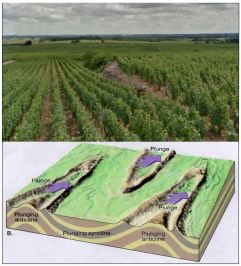
Interestingly, the effects of hydrostatic stresses upon an object are mitigated by oppositional forces. For example, the stress from below counteracts much of the force from above, and the forces from the right side counteracted by those from the left as they push against each other. So unlike directed stress, (the kind of stress that a 2 ton object exerts on top of a man), hydrostatic stress is like a scuba diver in the ocean. The stress of water upon the diver can be the same as the heavy weight upon the man, but because of counteracting stresses, strain is not expressed in the same way.
- Shear stress is that which is parallel to an object. Shear strain (caused by shear stress) changes the angle of an object. It can cause slippage between two objects when the frictional resistance is exceeded, or even failure within an object. Faulting is an example of slippage under shear stress. I would be remiss to note that faults in Burgundy, at least to my anecdotal eye, often occur between limestone types.
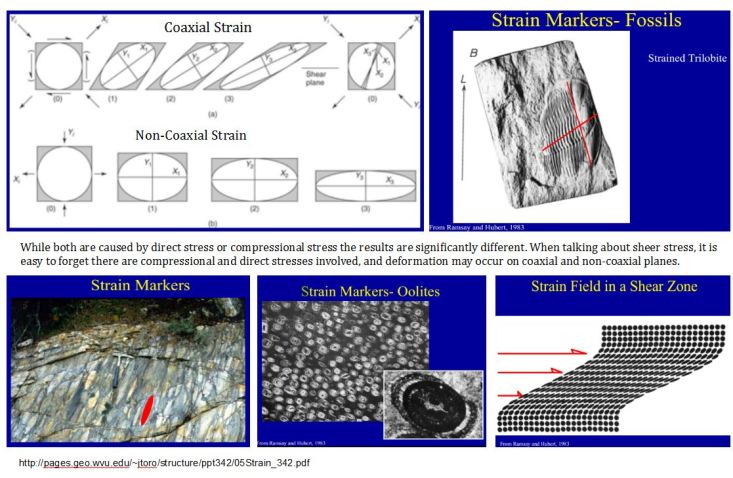
The Magnitude of Strain
Elastic strain and ductile deformation
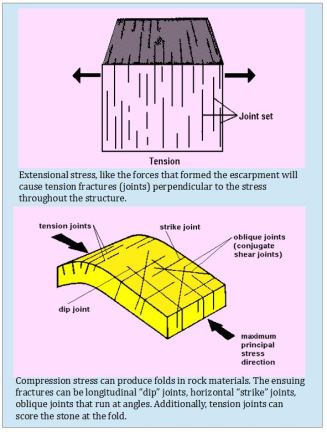 There are two levels of strain. Elastic strain, in the effects of the strain, are reversible. The stone will change shape or deform under stress, with minimal damage to its structure, and then return to its original shape and position.
There are two levels of strain. Elastic strain, in the effects of the strain, are reversible. The stone will change shape or deform under stress, with minimal damage to its structure, and then return to its original shape and position.
Ductile strain, is the area of strain once past the elastic level. The stone is now developing microscopic fissuring, and the stone can not return completely to its original size, shape, or position. Although the stone may not appear to be visibly damaged, any deformation into the ductile range, will harm the stone’ structural integrity. Additionally, in comparison to the deformation of the stone in the elastic range, the speed and ease of ductile deformation increases quickly (in structural geologic terms). The deformation is now the result of micro-fissures that have emerged throughout the stone, and are now both propagating and enlarging. It is during this phase of rapid deformation that the stone can achieve dramatic folding from what had previously been flat, sedimentary stone.
By The Numbers: limestone limits
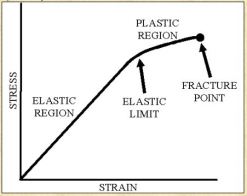
Author’s note: The measuring of deformation and the related stress involved becomes a bit more technical, and requires a number of lingo words to be used in the same sentence. I resist this as much as possible, because it requires the reader to be very familiar with the terms. Skip ahead if this doesn’t interest you, but it gives a numerical frame of reference for limestone fracturing.
The deformation under applied pressure is called flow, and the material’s resistance to deformation is measured (in newtons). The measurement of a stone’s elasticity is called it’s Elastic Modulus (a.k.a. Young’s Modulus).

The Elastic Modulus measures the tensile elasticity, meaning when a material is pulled apart by extensional stress. This resistance to deformation is expressed in gigapascals (GPa) which are one billion newtons per square meter.
Additionally, there is Bulk Modulus, the measurement of a stone’s lithostatic (compressed from all sides) elasticity. This is expressed in Gigapascals, (GPa) or one million newton units.
And Shear Modulus, also known as the Modulus of Rigidity, in which the elasticity of a stone under shear forces is measured. It is defined as “the ratio of shear stress to the displacement per unit sample length (shear strain)”.
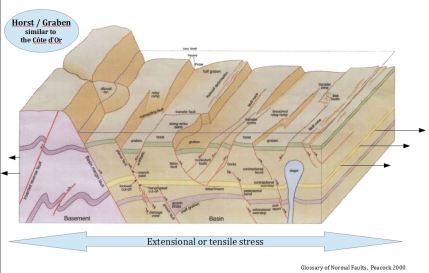
I gave the MPa compressional strength (loads that tend to shorten) of various limestone types in part 1.1. Note here MPa is used, or one million newtons per square meter. The elastic modulus of most limestone can be as low as 3 GPa for very impure limestone (we don’t know what was sampled), and up to 55 GPa depending on purity of the calcium carbonate. As a comparison of elastic modulus: Dolomite (limestone with a magnesium component) typically ranges between 7 to 15 GPa, while Sandstone typically runs 10 to 20 GPa.
-
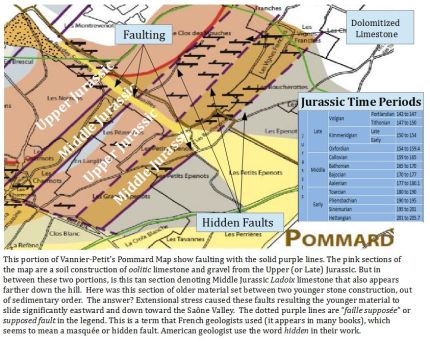
click to enlarge General Limestone Modulus Ranges (the range of deformation before fracture)
- Elastic modulus range: 3 GPa – 80 GPa
- Bulk modulus range: 5 GPa – 66.67 GPa
- Shear modulus range: 3.5 GPa to 33 GPa
The strain rate is important: which is expressed as elongation over time (e/t). The longer the period of time, the more the material can “adapt” to the strain. The faster the stress is applied exceeding the plastic elastic limit, the shorter the plastic region. The plastic region fracture where the material breaks and is considered brittle behavior.
- Brittle materials can have either a small (or a large) region of elastic behavior, but only a small region of ductile behavior before they fracture.
- Ductile materials have a small region of elastic behavior and a large region of ductile behavior before they fracture.
From Strain to Total Failure of Stone
The description of how stone reacts to crushing pressures reminds me of those submarine movies, where the hull is slowly being strained with a chorus of creepy groaning sounds, rivets popping and water spraying from leaks in the hull. In the laboratory, geologists study stones they crush, in order to understand what has occurred to rock materials over hundreds of thousands, to several million of years.
Infinitesimal strains refer to those that are small, a few percent or less, and is part of a mathematical approach material that is “assumed to be unchanged by the deformation” (Wikipedia). As deformation increases, micro-cracks and pores in the stone are closed and depending on the orientation of the pores in relation to the direction of the stress, this can cause the stone to begin to deform in a coaxial manner. This non-linear deformation is obvious in weaker or more porous stone.
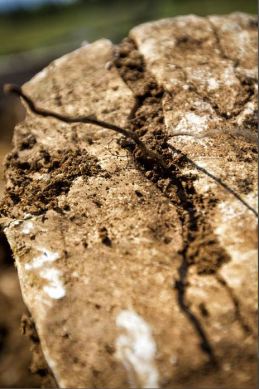
While in the elastic region, stone adjusts to the pressure applied to it. Micro-cracks don’t appear in the stone until it reaches the 35%-40% way-point in elastic region. At this point structural strain is largely recoverable with little damage. At 80% of the elastic limit, micro cracks are developing independently of one another, and are evenly dispersed throughout the stone’s structure, despite the fact that the stone is at maximum compaction with no volume change. As the stone nears its elastic limit, micro-cracks are now appearing in clusters as the their growth accelerates in both speed and volume. The stones appearance and size remains intact as it passes its peak strength, although the structure is highly disrupted. The crack arrays fork and coalesce, as they begin to form tensile fractures or shear planes, depending on the strength” of the limestone.(1) The rock is now structurally failing, and considered to have undergone “strain softening”. Additional strain will be concentrated on the most fractured, weakest segments of the stone, creating strain and shear planes in these specific zones, which as it nears the fracture point will essentially become two or more separate stones, ironically bound together only by frictional resistance and the stress that divided them. information source: Properties of Rock Materials, Chapter 4 p.4-5, (LMR) at the Swiss Federal Institute of Technology, Lausanne
The Bottom Line on the Fracturing of Limestone

The truth is that we don’t have any records detailing the condition of the limestone base that lies below the topsoil. Certainly the limestone base has been exposed often enough over the past century, that had some academic organization wanted to catalog this kind of information, there would now be a large database to refer to by now. Moreover this would be a substantial advance in the knowledge of how to farm these vineyards. Today, the most progressive vignerons are now making these inquiries themselves, digging trenches to find out what lies below in order to make the best replanting and farming decisions possible. But it is unlikely that even these recent efforts are being catalogued, as they investigated.
Vineyard Development: Limestone
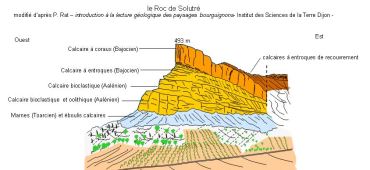
As a tilted bedding plane, The Roche (Roc) de Solutre and Vergisson, despite their distance South of the Cote de Nuits, and their slightly more youthful age, gives an unique glimpse into the layers of limestone in Burgundy. It reminds us, that whatever the top layer is, there lies different strata just below it. Click to enlarge
Limestone fracturing and shallow soiled vineyards
Since deeper soils do not require the vine to penetrate the bedrock in order to have a successful vineyard, fracturing there is not required for vineyard vitality.
However any vineyard where there is shallow soil, the limestone below must be compromised structurally, to some degree, for the vines to penetrate the stone. In this way, the vines themselves are a contributor to mechanical weathering of stone in the vineyards. Limestone varieties with a high percentage of impurities, are typically more easily fractured; although they may actually be soft enough, or porous enough stone for the vines to penetrate on their own. It is documented that composite formations with heavy fossilization (like crinoidal), or clay content (like argillaceous limestone) are less elastic than purer limestones with high levels of CaCO3, and are much more friable. You can read about limestone construction in Limestone: part 1.1.
With a harder stone, would significant ductile deformation with fissuring make the stone weak enough for the vine roots to penetrate? Or does a limestone based vineyard need to be significantly fractured before vines can sufficiently take root? That answer to this question is not apparent with the information available at this time, but the answer is probably yes.

Vineyards like Mazy-Chambertin and Ruchottes-Chambertin give evidence that the more brittle Premeaux limestone (with its lower compressive strength, and higher porosity), if fractured enough, can support vineyards, despite there being very shallow topsoil. There are a number of linear, east-west oriented, limestone outcroppings in these two vineyards, indicating this area has seen significant compressional stress to the bedrock there over the last 35 million years, in addition to the tensile faulting caused by extensional stress that created the region. These two stresses would have created vertical dip joints, and horizontal, strike joints, and very possibly diagonal oblique joints, and fissuring in the bedrock. Enough for the vines to survive well enough for these two vineyards to be awarded grand cru status in the late 1930s.There has been a question in my mind whether Comblanchien, which is so dense that water cannot penetrate enough to effect freeze thawing, and is also very elastic due to its 98% calcium carbonate content, would fracture enough in a vineyard location to support a vineyard in shallow soils. In fact that has been a driving question throughout this piece, and which I was inclined to believe the answer was no, until evidence proved otherwise. Apparently that has happened.
The Rise of Colluvium
In terms of vineyard soil development itself, geologic pressures have worked extensively to prepare the limestone bedrock. Primarily with extensional stress, but also exerting compressional stress, the strain significantly weakened and fractured the limestone bedding. This deformation and the ensuing fracturing allowed water to infiltrate its cracks and crevices. During periods of cold weather it would freeze within the fissuring, causing frost wedging. Exfoliation would ensue, ultimately causing significant limestone debris to be pulled away by gravity, itself a powerful force of mechanical weathering, to slide (and tumble) down the hillside. As the stones fell, they would further break and abrade into yet smaller pieces. Abrasion is another agent of weathering. There they would stop at the curb of the slope, where eventually they form deep, limestone-based “colluvium” soils. This is what Coates is speaking of when he wrote “rock and more limestone on the section closest to the over-hang, and there is some sand” in Amoureuses. These are the colluvium soils that would with enough time would generate the vineyards upon the the red grand cru vines of the Cote de Nuits would grow.
But first, the story of chemical weathering would have to play out, creating clay and soil needed to feed the vines. The slopes of the Cote d’Or would slowly evolve geologically for millions of years, awaiting the arrival Roman agriculturalists who would recognize and exploit the vinous wealth of this thin strip of the hillside.
Next up: Part 1.3 Amoureuses and Parallel Evidence of Shallow Soils over Comblanchien
Please feel free to comment, like, follow, share, or re-blog this or any of this terroir series!
_________________________________________
(1) Because it is often difficult to distinguish between the different types of fractures and faulting once the fracture has occurred, I will leave it at this. There are 3 kinds of fractures born from the three major stresses: Shear, tensile, and extensional.
(2) I have not been able to determine if crystallization is a definition of Comblanchien limestone, or if the Comblanchien limestone in the villages Corgoloin and Comblanchien just happen to have been metamorphosed into marble, and that is why it is quarried there.
Previous articles on Terroir
Limestone Construction: part 1.1 (click here)
Introduction to Terroir (click here)
Preface to my article on Terroir (click here)
Marl: The Most Misused and Misunderstood Word in Burgundy Literature? (click here)
_________________________________________

Dear Dean,
With regards to your comment that we may never see a successful vineyard with thin soil over Comblanchien limestone, both Clive Coates in “My Favorite Burgundies ” and Norman Remington in “Grand Cru” mentioned that Les Amourueses has thin soil of 20 to 60cm over Comblanchien. I agree with your comment that Comblanchien is impenetrable so I am at a loss with this seemingly contradictory information. I am wondering if you can shed some light on this? Thank you very much.
Warm regards,
Victor Liang
LikeLike
I had intentionally not discussed this exact issue, because there are some powerful people involved, and lots of egos to bruise. While I’m quite wary of ending up taking on the whole upper echelon of the wine world, I can’t help but question the status quo. I brought this “Comblanchien” issue up to Neal Martin when he mentioned that limestone below Amoureuses (via email – we’re not that close:-). He kindly responded saying he found the Comblanchien info in “My favorite Burgundies”.
Most likely the limestone under Amoureuses was misidentified. I’m assuming since Comblanchien is the most famous stone, it gets attributed to many types of limestones.
That said, Coates has been doing this for a very long time, and I get the impression he’s not doing much serious research anymore, and you can hardly blame him. I have discovered 4 inaccuracies from him recently (dating back to 2008), and some of this information has been parroted by others who should know enough to spot them, which is the danger.
See my section on Marl https://diaryofawinebuyer.wordpress.com/2014/12/09/marl-the-most-misused-or-is-it-the-most-misunderstood-word-in-burgundy-literature/
Thanks for the thoughtful question. I hope I don’t get the wrath of the “Masters” raining down on me!
LikeLike
Dear Dean,
Thanks for your quick reply! Typically, when I read about a plot with thin soil and a hard/semi-hard limestone (Comblanchien & Premeaux?) as the underlying bedrock, I’m skeptical precisely because I don’t think the vines would develop a good root system. But with the case of Les Amoureuses, due to a stone quarry basically slicing off a corner of it, exposing the sides, it would seem less likely for them to get it wrong. Puzzling.
Best,
Victor
P.S. Are you a geologist? Your articles are very in-depth.
LikeLike
Good point about the quarry at Vougeot. Yes, there are more questions than answers. This is precisely why we need wine writers spending more time walking vineyards and talking to professors than tasting Rousseau barrel samples. Allow me to play devil’s advocate.
First,The Cote is riddled with faults, and for the most part they are poorly documented. As faults often divide limestone types, could there have been a change of stone between Amoureuses and Les Perrieres? There was likely a reason they chose to use that spot as a quarry. They didn’t choose the Clos Vougeot, or Amoureuses, and they didn’t choose Musigny. They chose the least valuable land, Les Perrieres.
Secondly, the abbey was built in 1551, and the quarry was dug for the limestone to build it. Is the Abbe built of Comblanchien? I don’t know. If it is, it proves that the upper part of Les Perrieres was Comblanchien, but does it prove Amoureuses is as well? Until a geologist verifies the rock below Amoureuses, I’ll be a skeptic.
No, not a geologist. Unfortunately there are too few geologist who love Burgundy. I am a Burgundy lover and wine professional (20 years), who wants some answers about what’s really the story of terroir. No one was writing the anything to satisfy my questions, so I decided to explore the topic myself. This series represents hundreds of hours of research and writing. Thanks for reading carefully. Like you, I’m looking closely for answers.
LikeLike
Victor, at 5am I’m at my most creative. I had a couple other thoughts regarding Amoureuses. I’ll take them in order of origination. First thought as I woke up was: If Amoureuses is indeed fractured Comblanchien, and is a continuation of the stone in the neighboring Les Perrieres, wouldn’t that stone have been too fractured to use for construction?
Then I moved to thinking about the terracing in the vineyard, which is likely caused by faulting. If the vineyard had multiple faults (extensional strain), there could be (along with significant fracturing), multiple limestones exposed (since they are laid down in beds). Additionally, because the stone is a bedding, what is right on top, is not solid all the way down. What layer is below the first layer of stone?
Next I remembered that Amoureuse has is cited as having an convex curve to its topography, which is much more like the hillsides of the Cote de Beaune, whereas the rest of the Cote de Nuits has a concave curve to it. The concave curve in the rest of the Cote de Nuits, is due to the harder Comblanchien cap rock that sits above the vineyards. At Amoureuses, something entirely different is going on, and I don’t think can be explained by saying one limestone, the hardest limestone, that has the least amount of impurities (impurities which would help support the vines in an all limestone environment) is the answer.
LikeLike
Hi, Dean,
Funny that you should mention the convex nature of Les Amoureuses. This was also one of the features that led me accept that Comblanchien may actually be the bed rock under Amoureuses. I assume that if a hard limestone is the top layer, it acts as a cap rock and would probably tend to erode near the edge between the slope and cap rock faster, forming a convex feature. This convex topology probably explains the apparent random nature of the Les Amoureuses-Les Haut Doix border also. Les Haut Doix probably starts to slope down more and loses additional soil to the eastern side, and it probably slopes down the north side a bit(due to the land shaping effects of La Combe Ambin’s ancient run-offs and alluvial fan?), giving it a less favorable north-east exposure?
Norman Remington mentioned that there is a north-south fault a 3rd of the way up from the road between Le Musigny and Amoureuses, in Le Musigny. The uphill side of the fault is marl (?) and the downhill side is Comblanchien. The soil over the Comblanchien side of Musigny is thicker than that of Amoureuses, probably because more of the slope wash is retained there. So he gives a bit more detail than Clive Coates, implying to me that someone, if not him, did a more detailed study of the terroir there. He also mentioned that the layer beneath the Comblanchien is Oolite. Perhaps the Comblanchien under Les Amoureuses is indeed fractured, as you mentioned.
Best,
Victor
LikeLike
Hi Victor,
If a hard stone is an upper layer of Amoureuses, I would think if it were thin, it be may more prone to fracturing. Or if the pressure was significantly swift enough and the weather cold enough, perhaps it could shatter. The more specific the information, the greater the quantity of information, the less flip calling the stone “Comblanchien” sounds. However, I do get suspicious when marl is listed as one limestone type, and Comblanchien the other! These French terms mess up English speaker’s understanding of terroir. To completely avoid that, if I write the word Marl, I usually write (clay + limestone) behind it, and try to be clear I’m talking about a soil type, not a stone.
I agree about a harder stone could be responsible for the convex nature of the vineyard, especially since there is thin soil there. Although,extensional faulting, pulling the sections down and away, may be the explanation.
I had not seen Norman’s passage before. What producer is he talking about when he divulges these gems of information! Thank you for sharing your passion of vineyard sites, and eye for detail and accuracy. It is much enjoyed and appreciated!
By the way, I edited my post from early yesterday morning, so a sane person might be able to understand what I was trying to say. Apparently my coffee hadn’t kicked in and I was writing in tongues!
Best,
Dean
LikeLike
Hi, Dean,
Norman talks about the topography/geology of each Grand cru vineyard in Burgundy in his book, “Grand Cru”. He also added a few 1’er cru vineyards that everybody in general believes to be of Grand cru quality, such as Les Amoureuses and Clos St. Jacques.
However, he doesn’t use diagrams or maps to help with his explanations. Instead, he uses words like “east”, “west”, “south”, “upper sectors”, “down slope”, etc, which makes it harder to follow. I think there are some inconsistencies also. For example, in the section talking about Le Musigny, he says “…there is another fault; this separates the marls to the east from Comblanchien limestone to the west”. I assume that east is down slope, while west is up slope. However, in the next sentence, he says “…downslope the rock is hard and compact Comblanchien limestone”. Since in the next section on Les Amoureuses, he says it is on “a bedrock of compact Comblanchien limestone…”, I assumed that he got the “east” and “west” crossed.
In the book, he has a chapter explaining the morphology, geology, and pedology of the cote, which, although not perfect, is a decent attempt (still some inconsistencies, especially when he talks about Comblanchien being unsuitable for vintculture, except where it occurs in mid or lower slope, then he quotes Les Amoureuses as an example. But later in the Les Amoureuses section, he says it is Comblanchien just beneath the top soil.
BTW, I noticed you mentioned that you use Google Map’s street view to help you see the topology of the vineyards. I actually do that, too! If you haven’t already, you can also use Google Earth, which gives you a birds eye view. You can really see the topology; and it really helps you understand why the combes are so important. By looking at Les Amoureuses through Google Earth, I could see that there is actually three distinct sections: the plateau, the south-east sector that Vogue owns, and the east-facing slope. Using street view alone, you don’t see it as well. Try it out if you haven’t yet.
Best,
Victor
LikeLike
I found the proof that a vineyard can exist Comblanchien with very little topsoil, meaning it can fracture substantially. I finally discovered the Marsannay press kit featuring Vannier-Petit’s work, and mapping of the limestone and faulting. I will explain in a near future post. And I will improve my limestone post ASAP! Always searching out the truth, even if it proves me wrong!
LikeLike
I was surfing the net about this subject and happened upon a website, wineguide.com.au. It mentions that Vannier-Petit consults for Allen Meadows, Jasper Morris, Remington Norman, Clive Coates, and Anthony Hanson, among others, about geological research. It also mentioned that Vannier-Petit said that the Les Amoureuses is situated over hard limestone, implying either Premeaux or Comblanchien, with thin soil over it. It was also mentioned that some of Robert Groffier’s vines in the upper reaches of Les Amoureuses has problems with surviving because of this. So I think both Coates and Norman got their info from Vannier. Very interesting.
Victor
LikeLike
I really like that article/blog piece. Very disappointed that the promised part 2 never got written. Another good blog article is this: http://mindfullofwine.com/further-into-pandoras-box/#sthash.0FX6JqS2.dpbs
What I would really like to see is a photo of a yard by yard section with all the topsoil removed. How hard would that be. It would definitively answer the question of what does fractured mean in terms of planting a vineyard. Am I right?
LikeLike
Yes, there is a small path that leads into the heart of the vineyard. The entrance to this patch is on the road between Le Musigny and Les Amoureuses. They could dig it there without having to affect any vines.
LikeLiked by 1 person
I thought the Marsannay information was illuminating, though of course, I really wanted even more definitive answers. Did you?
I found another location to view fractured limestone still in place in Meursault.
If you take a “google driving tour” of Meursault, (or on your next actual trip to Burgundy), if you take the road that threads up between Genevrieres Dessus and Dessous from the village of Meursault, make a right turn when you reach the intersection with Les Perrieres Dessous and Charmes Dessus. As the road goes up the hill, it turns left at the back edge of the vineyard, to go up to Blagny and the upper portions of Meursault Perrieres (Dessus). At the bend in the road are at least 3 different limestones next to one another in quick succession, one white, one yellow, (obviously both are hard, nearly pure calcium carbonate), both which are heavily fractured but in situ. A few yards up the road is a darker stone lip, completely unfractured. I may do a photo piece on this soon, exploring Perrieres, with nothing more than (what is bound to be incorrect observations;-)
Well, back to the hunt for more answers. I should finish my soil piece today. Not as sexy as limestone, but just as important.
LikeLike